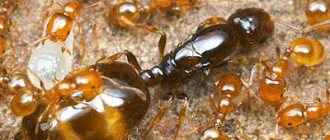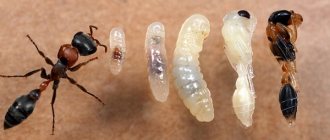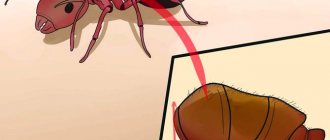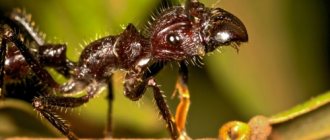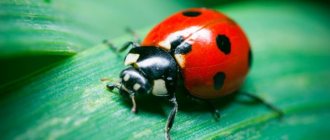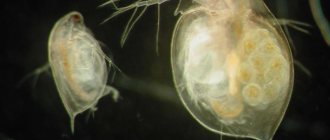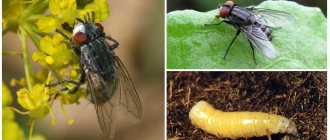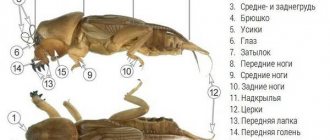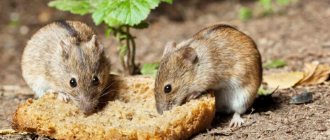Private houses and city apartments are increasingly becoming habitats for ants. They come to human habitation in search of an inexhaustible source of food and warmth. The presence of such a place allows insects not to think about wintering, not to hibernate during cold weather, and to always have food.
Optimal living conditions for ants are high humidity and a temperature of about 20°C -30°C. For food, they prefer to consume sweet drinks, crumbs from flour products, cereals, fruits and other dishes that are publicly available in the apartment.
The house can be favored by red, black and yellow ants. If one or more single individuals are found in an apartment, you should immediately take measures to destroy them. The peculiarities of their lifestyle, physiology and reproduction complicate the process of fighting insects. For the process to be effective and to obtain the expected result, you need to know how to find the queen of a colony, clusters of individuals and a nest of ants in an apartment. This is usually a hard-to-reach, dark, warm and damp place in the kitchen, bathroom or bathroom. You should carefully inspect the openings in the walls for sockets and switches, the space between the tiles and under the baseboard, cracks and holes in the wooden floor.
Often the nest is located not in the apartment itself, but between floors. If the ant population has become large enough, they begin to expand their habitat into neighboring rooms. Specialized teams equipped with professional equipment will help destroy insects in interfloor ceilings.
Helpful advice
Passive observation is often the most effective way to detect insects in an apartment. Study the direction where insects take food. If they go into holes, then silicone sealant will help cut off their path to the food source.
Ants in the apartment: how to find a nest
If the fight against ants was successful, you should study the reasons that lead to the appearance of these insects. Information is necessary to prevent recurrence of unpleasant events. A high risk of ants appears in private country houses with unfavorable sanitary conditions. The colonization of insects is facilitated by a large amount of garbage, food in the public domain, crumbs and spilled drinks on the table, and unwashed dishes. In city apartments, ants often appear as a result of migration from neighboring rooms, garbage chutes, attics, basements and interfloor ceilings.
What to do if there are ants in the apartment, how to find the nest? In this case, it is necessary to identify the queen of insects. It is not enough to destroy other inhabitants of the nest, as the population will quickly recover. Passive observation is the main way to detect the habitat of a colony. Ants choose secluded and hard-to-reach places with high humidity and comfortable temperatures. These can be ventilation holes, cracks in the floor and walls, baseboards, and various cavities.
Experienced insect exterminators will help you quickly find an ant nest. Using professional equipment, they are able to examine and treat hard-to-reach places in the house, attics, basements and interfloor spaces.
The life of a queen from birth to the founding of her colony
There are always a lot of both males and females in colonies, but not all “females” are capable of fertilization. Those of them that can produce offspring mate with the opposite sex in the summer, after which they either return to the mother colony (if they are red ants) or go in search of a good place to found their settlement. They move not so far from their place of birth and subsequently “keep in touch” with their first anthill.
If an ant was born female, this does not mean that it will live long and is a queen
The future queen is looking for a place for her kingdom using her wings. After she has decided on the location, the female lays the first eggs and sheds her wings or chews them off. The queen does not look for food for her offspring, but feeds them either with eggs specially laid for this purpose, or with fat reserves and deteriorating wing muscles.
Ant queens mate only once in their lives, after which the female spends the resulting supply of sperm throughout the remaining years.
The uterus itself controls how many and what kind of individuals it “gives birth to”
It is quite difficult to say in advance whether a female is a queen, because this is determined not only by her ability to reproduce, but also by her life expectancy. If she lives longer than an ordinary ant, then she is a queen, if not, then she was not one.
The queen rarely eats herself: there are special “court” ants that pre-chew food and then give it to the queen. Such food is easier and faster to digest, which is exactly what is needed for the one on which the well-being of the entire colony depends. It feeds mainly on protein foods.
Parasitism on other colonies
All ants, with the exception of one species, either create their own colonies in a new place, or live with their “mother”. Only Formicoxenus Nitidulus climb into someone else's anthill and live there happily. Of course, the “guards” “grab” them, but that’s where the matter ends. Scientists suggest that Formicoxenus Nitidulus secrete a secret that repels other ants. The queen of such parasites can quite easily settle in any other anthill and create her offspring there.
Formicoxenus Nitidulus parasitize on foreign colonies
Video: Queen ant lays eggs
What does an ant queen look like?
The main rule for effective ant control is to find and destroy the queen. This is the progenitor of the colony, which is able to quickly restore the population size if the workers die. In a couple of weeks, the number of insects can increase several times.
An ant colony is distinguished by a strict hierarchy, headed by the queen. Its main function is to organize the survival and growth of the population. It does not carry out work functions, does not obtain food, does not provide shelter, and does not protect the place from other insects. All other worker ants work for the benefit of its interests and ensure periodic replenishment of the colony with new residents.
To detect the progenitor of a population, you need to know what the queen looks like and how it differs from other ants. The following signs will help with this:
- body size is 2 times larger than that of working individuals;
- length up to 5 mm;
- brown chitinous shell;
- dark and round abdomen with light thin stripes up to 4 mm in size;
- low mobility;
- massiveness;
- developed and wide chest.
This structure of the ant uterus arises due to the initial presence of wings. Fertilized females that establish an anthill independently gnaw them off or discard them. The large abdomen is intended for laying eggs. Increasing the number of colonies is the main function of the uterus. Over the course of her life, she can lay up to 500 thousand eggs.
Description of the queen ant
The ant family has its own hierarchy:
- working individuals that collect food and building material, look for new feeding points;
- service personnel who care for eggs, larvae and life in the anthill;
- The queen is the main unit of the colony, since the survival of the colony depends on it.
Any female capable of reproduction can become a queen.
Externally, the queen ant looks different from other individuals. It is twice as large as its relatives - 4-4.5 mm. The breast is larger than the head and the abdomen is voluminous. The body is dark brown in color and has red bandages on the belly.
The queen of the colony has no wings. After giving birth to the first offspring, she chews them off. Other young female house ants are winged, but not adapted to summer.
The queen ant does not appear on the surface, and therefore it is very difficult to detect it in the apartment. You are unlikely to be able to find and neutralize it yourself. But you can monitor its habitat with the help of the same worker ants that bring food to the queen. But more on that later.
Queen ants are much larger than worker ants
How to find the queen ant in an apartment
One colony of ants can organize several nests around the house and have several main individuals. The only way to get rid of insects is to find and destroy all the queens. To estimate the scale of the disaster, you can multiply the number of detected individuals by ten. This is a method that allows you to approximately understand the number of ants living in the house.
How to find the queen ant in an apartment? Studying the following features of their lifestyle will help with this:
- To house the queen, worker ants choose warm and dark places. It is necessary to carefully inspect ventilation openings and hard-to-reach places in the kitchen, bathroom and toilet.
- Pay special attention to cupboards with cereals and areas near food products.
- Passive observation will help determine the location of the uterus. Look where the workers take the food they get.
- Ant nests can often be found on balconies, attics and basements of multi-storey buildings.
Carefully!
When fighting domestic cockroaches on your own, you should remember that killing worker ants will not bring the desired result. The queen quickly restores the size of the colony.
The role of the queen in the anthill
The queen does not work like other ants, does not protect the colony, does not look for building materials or food, she has a more important role - laying eggs. From them new individuals then appear, which take the place of ordinary workers. The queen is a special female in an anthill who has the ability to lay eggs. There are other females in the colony, but they do not give birth to “offspring”, but perform the same functions as other members of the community.
All ants serve the anthill and their queen, without whom they will die
The queen is the center of the universe for ants. Experience has shown that a colony will die in a matter of weeks if something happens to their queen. Knowing this, you can get rid of annoying “neighbors” in the house.
If the colony is very large (mainly in natural conditions), then there may be several queens. This is called polygyny. Queens lay eggs, they are given the same “care”, there is no preference for one queen over another. Therefore, if you decide to destroy an anthill, depriving it of its queen, but for some reason the colony remains in the same place, this means that there are several queens there.
In large ant colonies there may be several queens
Can an “ordinary” ant become a queen?
Primitive ant species do not have a queen, but have several females that can lay eggs. They act as a queen, but live as long as their counterparts. This means that the duration of the genus of this particular colony directly depends on the short life of the females: if all the egg-laying ants disappear, the anthill will be doomed to death.
A simple worker ant cannot become a queen
The queen lives 100 times longer than an ordinary ant (on average up to 15 years) and produces offspring of the colony for many years.
An ordinary ant cannot become a queen, it can only temporarily perform her functions, but a colony without a queen is obviously doomed to extinction.
Is the queen really the boss in the anthill?
The queen lives in the very depths of the anthill, so other living creatures, as a rule, cannot reach her, and some natural “disasters” (something fell from above, a strong wind blew and the ant was carried away, etc.) it is practically not affected. Throughout her entire life (and this is up to two decades), she does nothing but give birth to offspring. 90 or more generations may take place, and the queen will be alone and will lay eggs just as efficiently as in the first time after fertilization. Therefore, of course, the ant queen is the most important, significant unit of the entire ant kingdom.
Flood and fire are those natural disasters that can really destroy the queen ant
How to deal with ants in an apartment
All methods of fighting ants can be divided into several categories:
- folk remedies;
- ultrasonic repellers;
- mechanical traps;
- chemicals.
Folk remedies are represented by various aromatic herbs and spices. They are not highly effective in pest control. Traditional methods are suitable as deterrent measures that reduce the likelihood of ants reappearing. For this, plants with a strong aroma are used - mint, lavender, wormwood, tansy.
The most popular and effective methods of killing insects is the use of chemicals. On the market you can find a variety of gels, crayons, aerosols, powders, traps with glue and poisonous baits.
Ant Reproduction
Fertilization of the female occurs once in her life. Having received the male's sperm, she uses it up gradually. Unfertilized eggs produce males, and fertilized eggs produce females. Young insects grow wings. Mating of winged creatures occurs in flight. After fertilization, the males die. Males that are incapable of fertilization or have not found a mate are expelled from the anthill, some of them are killed by worker ants. Further life of the female:
- The female does not return to her former family. She goes in search of a separate place and creates a nest there.
- The first clutch of eggs pupates after 14-21 days. The female does not eat during this entire period. Her fatty glands store reserves, thanks to which she feeds herself and the larvae.
- After 1-1.5 months, worker ants are born from the pupae. The females no longer need their wings and chew them off.
- The uterus begins to multiply continuously. She does this even in winter, if environmental conditions allow. The first young take care of the ant queen and larvae, delivering food to them.
Insects easily navigate the terrain and are able to get out of the most confusing labyrinth. Formic acid helps them with this. It is also used when attacking an enemy and while defending a nest. Sometimes conflict situations arise within the family. This forces weaker ants to grab the larvae and flee the nest.
Interesting ! Each ant family has a guard that protects the personal space of the colony from attacks by insects from other families. Insects create long paths in their territory. The length of some of them inside the anthill stretches up to 7 km. Working individuals keep order and constantly keep them clean. They carry dead individuals outside the nest.
Stages of development
The domestic ant goes through a full transformation cycle, consisting of 4 stages. The development cycle of an ant from egg to adult lasts 30 days:
- First stage ( egg ). The eggs are oval in shape and resemble a transparent capsule in appearance. The size of each egg does not exceed 0.5 mm. The queen lays them in groups, several in a special compartment. Worker ants carry eggs in groups into the incubator. This is easy to do, as each egg is covered with a sticky substance. Nannies look after them for a month. They protect eggs from enemies, maintain humidity and air temperature in the chamber at an optimal level.
- Second stage ( larvae ). The larvae that emerge from the eggs look like white worms. They move little and cannot feed themselves. They are sorted by size and distributed into different compartments. To feed the larvae, adult insects chew food and then regurgitate it. Sometimes small leaves are brought to the worms. Which larva will turn out to be a queen, a male or a female, depends on the quality of food and the care it provides. Ants monitor and regulate this process.
- Third stage ( pupa ). The larva pupates within 7-8 days. She stops moving and doesn't eat. Some types of ants weave a cocoon around themselves from the outside. You can determine that the insect’s digestive system has formed by the black dot that appears at the end of the body. These are waste products that the pupa begins to secrete. The third stage lasts 21 days.
- Fourth stage ( imago ). The insect is not able to get out of the cocoon on its own. Adult insects help him in this by biting off the top of the shell. A light-colored imago with soft parts of the body is born. Outwardly, he looks like an adult. Within 2-3 hours, the ant darkens, becoming covered with a dense chitinous coating.
Female lifestyle
Many people do not realize that worker ants are also female. Only, unlike the queen, they cannot be fertilized. It is also a mistake to believe that there is only one queen of house ants in a nest. In fact, there can be up to two hundred of them, and in this case the offending individual will be killed by others.
Mating flight occurs once a year, usually in July or August . By this time, males and females hatch from the eggs, which are assigned the role of queens. They are all born with wings to fly out of the nest to mate and find a place for a new colony.
The average lifespan of a red ant queen is 10-15 years. Lays eggs all its life, more than 500 thousand pieces.
Each female is fertilized only once. The male reproductive cells that enter her body are stored in a special bag and are gradually consumed throughout the female’s life.
After mating, the queen may return to the old colony or build a new nest. If she manages to choose a place for the future anthill, then she builds a main chamber there, intended for laying eggs.
Before the emergence of working individuals, the offspring are fed with a special secretion of saliva, produced from shed wings or subcutaneous fat deposits. But since one female is not able to feed a large number of young, usually the first generation of an anthill is the smallest.
In total, queen ants lay up to 60 thousand eggs each during their lives, since they live much longer than all other insects. How many years the queen will live depends on what species she belongs to. On average, the life cycle for fertilized female house ants is about 20 years.
